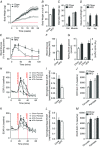Development of a high-throughput method for real-time assessment of cellular metabolism in intact long skeletal muscle fibre bundles
- PMID: 27619319
- PMCID: PMC5157063
- DOI: 10.1113/JP272988
Development of a high-throughput method for real-time assessment of cellular metabolism in intact long skeletal muscle fibre bundles
Abstract
Key points: We developed a method that allows for real-time assessment of cellular metabolism in isolated, intact long skeletal muscle fibre bundles from adult mice. This method can be used to study changes in mitochondrial function and fuel utilisation in live skeletal muscle fibre bundles. Our method enables flexibility in experimental design and high-throughput assessment of mitochondrial parameters in isolated skeletal muscle fibre bundles. Extensor digitorum longus (EDL) fibre bundles obtained from chronic high-fat diet fed mice had lower basal oxygen consumption under FCCP-induced maximal respiration, when compared to control chow-fed mice. EDL fibre bundles obtained from chronic high-fat diet fed mice had enhanced mitochondrial oxidation capacity under FCCP-induced maximal respiration, when compared to control chow-fed mice.
Abstract: Metabolic dysfunction in skeletal muscle contributes to the aetiology and development of muscle diseases and metabolic diseases. As such, assessment of skeletal muscle cellular bioenergetics provides a powerful means to understand the role of skeletal muscle metabolism in disease and to identify possible therapeutic targets. Here, we developed a method that allows for the real-time assessment of cellular respiration in intact skeletal muscle fibre bundles obtained from the extensor digitorum longus (EDL) muscle of adult mice. Using this method, we assessed the contribution of ATP turnover and proton leak to basal mitochondrial oxygen consumption rate (OCR). Our data demonstrate that the mitochondria in EDL fibres are loosely coupled. Moreover, in the presence of carbonyl cyanide-p-trifluoromethoxyphenylhydrazone (FCCP), we show that palmitate exposure induced comparable peak OCR and higher total OCR in EDL fibre bundles when compared to pyruvate exposure, suggesting that fatty acids might be a more sustainable fuel source for skeletal muscle when mitochondria are driven to maximal respiration. Application of this method to EDL fibre bundles obtained from chronic high-fat diet fed mice revealed lower basal OCR and enhanced mitochondrial oxidation capacity in the presence of FCCP when compared to the chow-diet fed control mice. By using a 96-well microplate format, our method provides a flexible and efficient platform to investigate mitochondrial parameters of intact skeletal muscle fibres obtained from adult mice.
Keywords: metabolic flux; method; muscle metabolism; seahorse; skeletal muscle fibre.
© 2016 The Authors. The Journal of Physiology © 2016 The Physiological Society.
Figures







References
-
- Archacka K, Pozzobon M, Repele A, Rossi CA, Campanella M & De Coppi P (2014). Culturing muscle fibres in hanging drop: a novel approach to solve an old problem. Biol Cell 106, 72–82. - PubMed
-
- Augusto V, Padovani CR & Campos GER (2004). Skeletal muscle fiber types in C57BL6J mice. Braz J Morphol Sci 21, 89–94.
-
- Banas K, Clow C, Jasmin BJ & Renaud JM (2011). The KATP channel Kir6.2 subunit content is higher in glycolytic than oxidative skeletal muscle fibers. Am J Physiol Regul Integr Comp Physiol 301, R916–R925. - PubMed
-
- Baron AD, Brechtel G, Wallace P & Edelman SV (1988). Rates and tissue sites of non‐insulin‐ and insulin‐mediated glucose uptake in humans. Am J Physiol Endocrinol Metab 255, E769–E774. - PubMed
Publication types
MeSH terms
Substances
Grants and funding
LinkOut - more resources
Full Text Sources
Other Literature Sources
Research Materials

